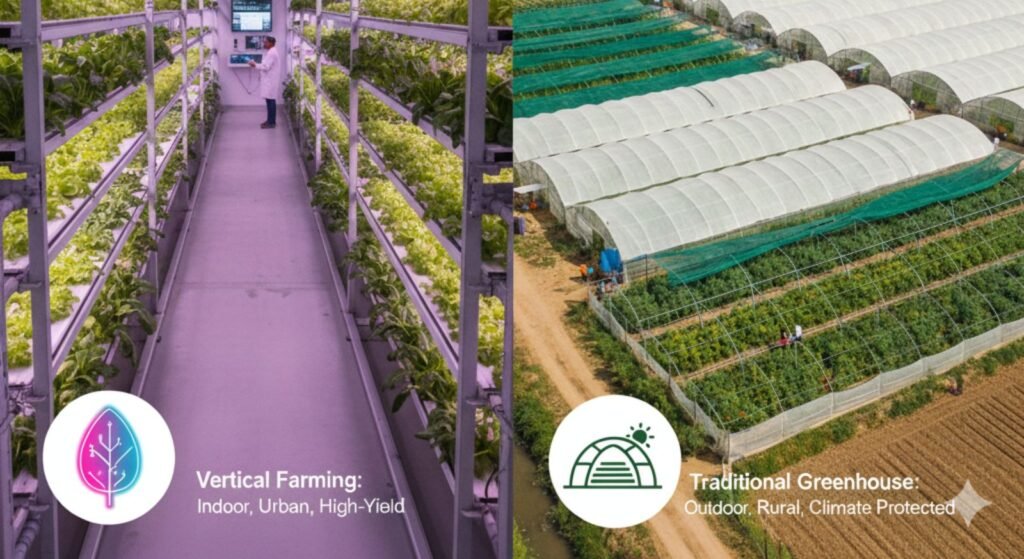India is at the cusp of an agricultural transformation. As urbanization spreads and climate change intensifies, traditional farming methods are being re-evaluated. Two modern approaches gaining attention are vertical farming and traditional greenhouses. Both promise higher yields and better resource efficiency, but they come with their own sets of opportunities and constraints.
What is Vertical Farming?
Vertical farming is the practice of growing crops in stacked layers, often using hydroponics, aeroponics, or other soil-less systems. It’s particularly popular in urban areas where land is scarce. By growing upwards instead of outwards, farmers can produce more food in smaller spaces.
Opportunities of Vertical Farming in India
- Land-saving: With growing cities, land for farming is limited. Vertical farms can thrive in urban settings, on rooftops or in warehouses.
- Water efficiency: These systems use up to 70–90% less water than traditional soil farming.
- Year-round production: Controlled environments allow crops to grow irrespective of season or weather.
- Reduced transportation: Urban vertical farms bring food closer to consumers, cutting down on transportation costs and emissions.
Constraints of Vertical Farming in India
- High initial investment: Setting up a vertical farm with lights, sensors, and hydroponic systems can be costly.
- Energy dependency: Artificial lighting and climate control can spike electricity bills.
- Technical know-how: Successful vertical farming requires knowledge of hydroponics, nutrient solutions, and plant biology.
- Limited crop variety: Leafy greens, herbs, and some vegetables grow well, but staple crops like rice or wheat are still difficult.
What is Traditional Greenhouse Farming?
Greenhouses are enclosed structures that protect crops from extreme weather while maintaining optimal growth conditions. Polyhouses and shade nets are common types in India. Greenhouses are widely used for vegetables, fruits, flowers, and high-value crops.
Opportunities of Greenhouse Farming in India
- Climate protection: Greenhouses shield crops from excessive heat, cold, wind, and pests.
- Higher yields: Controlled conditions lead to healthier plants and consistent production.
- Suitable for diverse crops: From tomatoes and capsicum to strawberries, a variety of crops can thrive in greenhouses.
- Lower technical barrier: Farmers familiar with traditional agriculture can adapt to greenhouse farming more easily.
Constraints of Greenhouse Farming in India
- Land requirement: Greenhouses still need significant space compared to vertical farming.
- Initial cost: High-quality greenhouse structures require investment in materials and irrigation systems.
- Maintenance: Nets, coverings, and frames need regular inspection and replacement.
- Limited urban adoption: Greenhouses are less feasible in dense cities due to space constraints.
Vertical Farming vs Greenhouses: Which One to Choose?
Choosing between vertical farming and traditional greenhouses depends on location, budget, crop type, and goals.
- Urban areas with limited land → Vertical farming is ideal.
- Suburban or rural farms with available land → Greenhouses may provide better ROI and crop diversity.
- High-value, leafy crops → Vertical farming excels.
- Fruits, vegetables, and flowers needing more space → Greenhouses are preferable.
Both methods can also complement each other. Some Indian farms are experimenting with hybrid solutions: vertical farming inside greenhouse structures for maximum yield and protection.
Final Thoughts
India’s agriculture is evolving, and both vertical farming and traditional greenhouses have roles to play. While vertical farming addresses urban space constraints and resource efficiency, greenhouses remain a versatile option for rural and semi-urban areas. The best choice depends on your resources, crops, and location, but both represent exciting opportunities for modern Indian farmers.
FAQs
Yes, but profitability depends on crop choice, scale, and market access. Leafy greens and herbs are the most profitable crops for vertical farms.
It’s possible, but technically challenging. Greenhouses are usually better for larger fruits and vegetables.
Depending on size, materials, and irrigation systems, costs can range from ₹5 lakh to ₹30 lakh per acre.
Yes. Various schemes under the Ministry of Agriculture and state governments support polyhouses and shade net structures.
Vertical farming is more suitable for cities due to space efficiency. Greenhouses are more feasible in peri-urban or rural areas.

